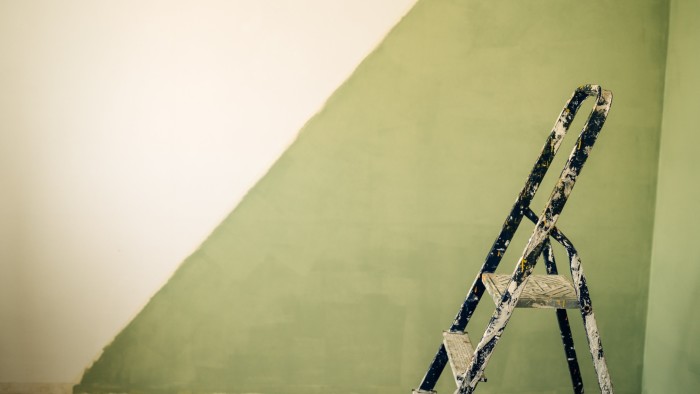Stay informed with free updates
Simply sign up to the House & Home myFT Digest — delivered directly to your inbox.
Renovations rarely, if ever, go smoothly. There are better chances of having a successful singing career after winning The Voice than a renovation running on time or within budget. When people get to the end of one, you never hear them say, “Well I can’t wait to do it again”. So why do I keep doing it?
The cost of construction materials has risen by around 40 per cent since 2019, according to the UK’s Department for Business and Trade — and there have also been steep rises where I live in Australia. With the eye-watering hourly rate for tradespeople, taking on some (or most) of a renovation yourself can be tempting.
For most people it’s a once-in-a-lifetime torture. For me, renovating has become a life-long punishment. In our 19 years together, my partner Jeff has dragged me through 35 projects. Sure, I’m still alive (just) and we’re still together (just), but while the finished product might be satisfying, the journey can be hazardous.
Though several haven’t been profitable, on balance, renovating properties has proven to be financially worthwhile. Jeff says I should also be grateful for all the lessons the process has taught me. At the risk of suggesting he’s right, here are just some of the things I’ve learnt.
Start small. We started with the home we were renting. I tried to convince Jeff that doing up a rental was a waste of money and might be illegal, but he told me (perhaps wrongly) that people do it all the time in his native UK. The risk paid off: we gave our apartment a lick of paint and the agent said she’d never seen a better-presented property. The bug had bitten.
Stick to your strengths. Ask yourself what you’re good at and what you enjoy. Plastering is meditative, tiling requires precision, landscaping gets you outdoors. Jeff and I divide and conquer — he’s meticulous (annoyingly demanding), I’m good at demolition (unresolved anger issues).
Social-media influencer wannabes have created a how-to video for every single renovation chore you could imagine. Watch them. It might save you a lot of time and stress in the long run.
Painting is a great place to start. I’ve painted the equivalent of what feels like the surface of the moon in various undiscernible-to-the-naked-eye shades of white. I hate painting: I can’t stand the monotony, the steady hand required, the destruction of clothing and the lengthy clean-up at the end of the day, only to repeat the whole process the next. But, aside from the time I was electrocuted when paint flowed from a spray gun on to the socket, painting has not caused me any harm.
Leave the most dangerous stuff to the professionals, and treat them like family — offer them drinks and lunch. Jeff has been hospitalised several times to have tiny things removed from his eyeball — melted plastic, metal shavings, wood chips. I’ve had a rusty nail pierce my elbow, debris tear my cornea and machinery turn my right hand into Flat Stanley’s. Jeff says we should apply for frequent crier points.
Be mindful of over-capitalisation, even if you’re not worried about making a profit. It’s easy to get carried away browsing Pinterest, deciding you just have to have a $12,000 Italian marble toilet. Fine if that’s been your life-long dream, but even mid-range finishes have a huge impact. Keep a record of everything you spend and a close eye on the local property market, even if you have no intention of selling in the short-term. What your neighbours sell for should inform your budget.
The floor plan is key. Carving up two bedrooms for a photography dark room, Monopoly-playing suite and ski storage unit might suit your lifestyle, but more bedrooms and bathrooms almost always means a higher valuation. Agonising over the layout before you even lift a hammer will set you on the right path.
Be aware of the potential personal costs, in terms of your relationship with whoever you are renovating with/for — and your own mental health. Look for the funny in everything you do. Don’t let the stress of dust, bills, delays and your substandard workmanship eat away at you. Always remember, there are always more stressful situations to be in, and stay focused on the prize (the day you don’t have to remove a dust sheet before climbing into bed).
Create a place where you’d be happy living. Jeff and I never planned this for our lives. We fell into renovating as a way to keep securing a more stable financial future. We couldn’t afford our dream home, so we looked for one with potential (and usually with the smell of cat’s urine). But for every decision, we stayed true to one thing — can we see ourselves living here? Because if we can’t, how could we expect potential buyers to?
Accept failure quickly — because not every project will go as planned. But amid all the pain, we remained agile and prepared to get our hands dirty . . . and cramped, bloodied and bruised.
My mother recently had her floors replaced, so while the house was temporarily empty Jeff and I stepped in to repaint everything — a job that friends of ours were just quoted A$25,000 (£12,000) to have done. Sure, I’d do just about anything for my mum, but a 25 grand paint job for free out of the goodness of my heart? Maybe I’m starting to enjoy the pain.
”The Worst House on the Worst Street: Nineteen Years in Renovation Hell” by Todd Alexander is published by Hachette Australia
Find out about our latest stories first — follow @ft_houseandhome on Instagram
